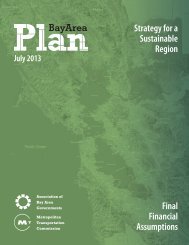Draft
Strategy for a Sustainable Region Priority ... - One Bay Area
Strategy for a Sustainable Region Priority ... - One Bay Area
- No tags were found...
Create successful ePaper yourself
Turn your PDF publications into a flip-book with our unique Google optimized e-Paper software.
PDA Readiness Assessment<br />
Final Report 3/29/13<br />
Transit Neighborhoods<br />
Transit Neighborhoods are primarily residential areas, well served by transit, but with existing<br />
low- to moderate densities. The two Transit Neighborhoods selected for this analysis, and the<br />
conditions and conclusions for each, are as follows:<br />
<br />
<br />
Benicia Downtown—This PDA encompasses the downtown area of Benicia, currently a lowdensity<br />
commercial district surrounded by Benicia’s residential neighborhoods. The<br />
Downtown has limited capacity for additional multifamily housing that is below the Plan Bay<br />
Area allocation. Capacity that does exist would likely be derived from some redevelopment<br />
of underutilized properties, including existing single family residential uses, though consistent<br />
with the City's downtown "form-based" zoning district. Constraints include a limited market<br />
for multi-family residential development and the limited access to regional transit facilities.<br />
Financial feasibility limitations will be caused by parcel assembly costs. The existing 40 foot<br />
height limit and community opposition to more intensive development may also deter some<br />
mixed use projects. Plan Bay Area allocates 930 new housing units to this PDA, well above<br />
the 429-unit capacity as measured by CD+A. Under the base scenario, EPS anticipates that<br />
343 housing units can be developed by 2040, or 37 percent of the Plan Bay Area allocation.<br />
The amended scenario assumes that redevelopment-type resources are re-introduced,<br />
increasing the City’s parcel assembly abilities and allowing infrastructure financing to take<br />
advantage of growing tax increment in the PDA. Under this amended scenario, EPS<br />
anticipates that development may increase to 429 units by 2040, or 46 percent of the Plan<br />
Bay Area allocation.<br />
Pittsburg Downtown—This PDA encompasses the downtown area of Pittsburg, the<br />
historical center of the City. Over the past several decades the City has pursued<br />
revitalization and redevelopment of the Downtown with its Redevelopment Agency and<br />
planning efforts. As a result, Downtown has created capacity for additional multifamily<br />
housing and mixed use development. This capacity is derived from several City-owned<br />
properties and redevelopment of underutilized properties, all consistent with the City's<br />
downtown zoning districts. Some rezoning of existing commercial properties, allowing mixed<br />
use, would expand existing capacity. Infrastructure needed to serve additional Downtown<br />
development is largely in place. Constraints to development include a currently limited<br />
market in Eastern Contra Costa County for multi-family residential development and the<br />
distance of the Downtown to planned transit service (eBART) or the existing Baypoint BART<br />
Station. Plan Bay Area allocates 1,823 new housing units to this PDA, well above the 700<br />
unit capacity as measured by CD+A. Under the base scenario, EPS anticipates that 636<br />
housing units can be developed by 2040, or 35 percent of the Plan Bay Area allocation. The<br />
amended scenario assumes the aforementioned rezoning and that redevelopment-type<br />
resources are re-introduced, increasing the City’s parcel assembly abilities and allowing<br />
infrastructure financing to take advantage of growing tax increment in the PDA. Under this<br />
amended scenario, EPS anticipates that development may increase to 990 units by 2040<br />
using all the estimated capacity, or 54 percent of the Plan Bay Area allocation.<br />
Mixed-Use Corridors<br />
Mixed-Use Corridors are linear PDAs served by transit lines, and typically feature commercial<br />
development extended along a major surface roadway with residential neighborhoods flanking<br />
Economic & Planning Systems, Inc. 26 P:\122000\121113 PDA Readiness Assessment\EPS\121113_finalreport_032913.docx




